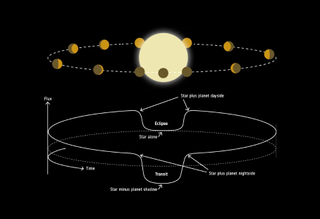The James Webb Space Telescope (JWST) has unveiled the secrets of a distant world unlike any in our solar system – WASP-43b. This scorching exoplanet paints a vivid picture of the incredible diversity of climates that exist beyond our cosmic neighborhood. Its existence challenges our perception of planets and compels us to contemplate the unimaginable extremes that celestial bodies can endure.
A World Forged in Fire: A Day of Unrelenting Heat
WASP-43b circles its host star at a blistering distance, completing a full orbit in a mere 19 Earth hours. This proximity subjects the planet to a relentless barrage of stellar radiation, pushing daytime temperatures to a staggering 2,300 degrees Fahrenheit (1,250 degrees Celsius) – hot enough to melt lead! Imagine a world bathed in perpetual sunlight, where molten rock flows freely and even the most robust metals would evaporate. This unrelenting heat paints a picture of a desolate wasteland, a testament to the unforgiving nature of a star’s embrace.
An Unending Night: A Realm of Frigid Darkness
In stark contrast to the blistering dayside, the permanent nightside of WASP-43b endures a frigid -1,110 degrees Fahrenheit (600 degrees Celsius). This extreme temperature difference classifies WASP-43b as a “hot Jupiter.” The relentless gravitational pull of its star has tidally locked WASP-43b, forcing one side to perpetually face the star while the other remains eternally shrouded in darkness. The JWST’s sophisticated Mid-Infrared Instrument (MIRI) peered through the veil, revealing a complex and inhospitable world on the nightside as well.
A Furious Dance: Winds of Fury and Molten Seas
The JWST observations unveiled a world ravaged by ferocious winds, reaching speeds over 5,600 miles per hour (9,000 kilometers per hour) – more than three times faster than the fastest jet fighter on Earth! These winds whip scorching hot material from the dayside to the nightside, where it condenses due to the frigid temperatures. Unlike the water vapor clouds adorning Earth or the ammonia clouds encasing Jupiter, WASP-43b’s nightside is likely shrouded in a bizarre blanket of molten rock clouds. This constant transfer of material creates a dynamic and turbulent atmosphere, a furious dance between the scorching heat and the frigid darkness.
A Spectral Symphony: Unveiling the Chemical Tapestry
By meticulously analyzing the infrared light spectrum emitted by WASP-43b, scientists were able to identify the chemical fingerprints of its atmosphere. The analysis confirmed the presence of water vapor throughout the planet, but surprisingly, revealed an absence of methane. This unexpected finding is attributed to the relentless winds, which prevent the necessary chemical reactions for methane formation on the nightside. Any minuscule amount of methane that might form is likely whisked away to the scorching dayside, where the intense heat ensures its destruction. The spectral analysis, a symphony of light and chemical signatures, paints a complex picture of WASP-43b’s atmospheric composition.
A Testament to Diversity: A Glimpse Beyond Our Oasis
The exploration of WASP-43b serves as a stark reminder of the remarkable diversity of planetary environments that exist within our universe. While Earth thrives in a delicate balance, WASP-43b exemplifies an extreme world, forever locked in a dance between blistering heat and frigid darkness. The JWST’s groundbreaking observations not only enhance our understanding of exoplanets but also highlight the uniqueness of our own life-sustaining oasis within the vast cosmos.
This research, published in Nature Astronomy on April 30, marks a significant milestone in exoplanet characterization. While the initial findings provide a captivating glimpse into WASP-43b, a follow-up study using the JWST’s NIRSpec instrument promises to further refine the temperature map and delve deeper into the planet’s chemical composition.

The James Webb Space Telescope continues to revolutionize our understanding of the universe, pushing the boundaries of scientific discovery and igniting our imagination with the wonders that lie beyond. WASP-43b serves as a captivating reminder that our universe is a treasure trove of diverse worlds, each with its own unique story to tell. As we delve deeper into the cosmos, these discoveries promise to reshape our understanding of planetary formation and the potential for life beyond Earth.



















